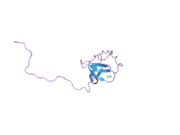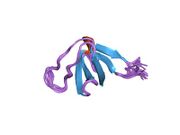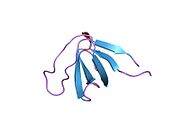Biology:HCK
 Generic protein structure example |
Tyrosine-protein kinase HCK is an enzyme that in humans is encoded by the HCK gene.[1]
Function
The protein encoded by this gene is a protein-tyrosine kinase that is predominantly expressed in hemopoietic cell types, and belongs to the Src family of tyrosine kinases. The encoded protein may help couple the Fc receptor to the activation of the respiratory burst. HCK and the Src family kinases have also been implicated in driving cell survival in drug-tolerant cancer cells. [2] In addition, it may play a role in neutrophil migration and in the degranulation of neutrophils. Alternate translation initiation site usage, including a non-AUG (CUG) codon, results in the production of two different isoforms, that have different subcellular localization.[3]
Interactions
HCK has been shown to interact with:
- ADAM15[4]
- BCR gene,[5][6]
- Cbl gene,[7][8]
- ELMO1,[9]
- Granulocyte colony-stimulating factor receptor,[10]
- RAPGEF1,[11]
- RAS p21 protein activator 1,[12] and
- RASA3.[12]
References
- ↑ "Identification of a human gene (HCK) that encodes a protein-tyrosine kinase and is expressed in hemopoietic cells". Mol Cell Biol 7 (6): 2267–75. August 1987. doi:10.1128/mcb.7.6.2267. PMID 3496523.
- ↑ Saha, Tanmoy; Mondal, Jayanta; Khiste, Sachin; Lusic, Hrvoje; Hu, Zhang-Wei; Jayabalan, Ruparoshni; Hodgetts, Kevin J.; Jang, Haelin et al. (2021-06-24). "Nanotherapeutic approaches to overcome distinct drug resistance barriers in models of breast cancer" (in en). Nanophotonics 10 (12): 3063–3073. doi:10.1515/nanoph-2021-0142. PMID 34589378. Bibcode: 2021Nanop..10..142S.
- ↑ "Entrez Gene: HCK hemopoietic cell kinase". https://www.ncbi.nlm.nih.gov/sites/entrez?Db=gene&Cmd=ShowDetailView&TermToSearch=3055.
- ↑ "Phosphorylation-dependent interactions between ADAM15 cytoplasmic domain and Src family protein-tyrosine kinases". Journal of Biological Chemistry 277 (7): 4999–5007. Feb 2002. doi:10.1074/jbc.M107430200. PMID 11741929.
- ↑ "The interaction of the Bcr-Abl tyrosine kinase with the Src kinase Hck is mediated by multiple binding domains". Leukemia 17 (2): 283–9. Feb 2003. doi:10.1038/sj.leu.2402778. PMID 12592324.
- ↑ "Transformation of myeloid leukemia cells to cytokine independence by Bcr-Abl is suppressed by kinase-defective Hck". The Journal of Biological Chemistry 275 (24): 18581–5. Jun 2000. doi:10.1074/jbc.C000126200. PMID 10849448.
- ↑ "Membrane-anchored Cbl suppresses Hck protein-tyrosine kinase mediated cellular transformation". Oncogene 21 (11): 1707–16. Mar 2002. doi:10.1038/sj.onc.1205228. PMID 11896602.
- ↑ "The proto-oncogene p120(Cbl) is a downstream substrate of the Hck protein-tyrosine kinase". Biochemical and Biophysical Research Communications 257 (1): 129–38. Apr 1999. doi:10.1006/bbrc.1999.0427. PMID 10092522.
- ↑ "Identification of novel SH3 domain ligands for the Src family kinase Hck. Wiskott-Aldrich syndrome protein (WASP), WASP-interacting protein (WIP), and ELMO1". The Journal of Biological Chemistry 277 (31): 28238–46. Aug 2002. doi:10.1074/jbc.M202783200. PMID 12029088.
- ↑ "The Src-like tyrosine kinase Hck is activated by granulocyte colony-stimulating factor (G-CSF) and docks to the activated G-CSF receptor". Biochemical and Biophysical Research Communications 251 (1): 117–23. Oct 1998. doi:10.1006/bbrc.1998.9441. PMID 9790917.
- ↑ "Physical and functional interaction between Hck tyrosine kinase and guanine nucleotide exchange factor C3G results in apoptosis, which is independent of C3G catalytic domain". The Journal of Biological Chemistry 278 (52): 52188–94. Dec 2003. doi:10.1074/jbc.M310656200. PMID 14551197.
- ↑ 12.0 12.1 "The Ras GTPase-activating protein (GAP) is an SH3 domain-binding protein and substrate for the Src-related tyrosine kinase, Hck". The Journal of Biological Chemistry 270 (24): 14718–24. Jun 1995. doi:10.1074/jbc.270.24.14718. PMID 7782336.
Further reading
- "Structure--function relationships in HIV-1 Nef.". EMBO Rep. 2 (7): 580–5. 2001. doi:10.1093/embo-reports/kve141. PMID 11463741.
- "The role of Vif during HIV-1 infection: interaction with novel host cellular factors.". J. Clin. Virol. 26 (2): 143–52. 2003. doi:10.1016/S1386-6532(02)00113-0. PMID 12600646.
- "HIV-1 Nef control of cell signalling molecules: multiple strategies to promote virus replication.". J. Biosci. 28 (3): 323–35. 2004. doi:10.1007/BF02970151. PMID 12734410.
- "HIV/SIV escape from immune surveillance: focus on Nef.". Curr. HIV Res. 2 (2): 141–51. 2004. doi:10.2174/1570162043484924. PMID 15078178.
- "Nef: "necessary and enforcing factor" in HIV infection.". Curr. HIV Res. 3 (1): 87–94. 2005. doi:10.2174/1570162052773013. PMID 15638726.
- "Modelling thymic HIV-1 Nef effects.". Curr. HIV Res. 4 (1): 57–64. 2006. doi:10.2174/157016206775197583. PMID 16454711.
- "Human protein-tyrosine kinase gene HCK: expression and structural analysis of the promoter region.". Oncogene 7 (5): 849–58. 1992. PMID 1373873.
- "The genomic locus of the human hemopoietic-specific cell protein tyrosine kinase (PTK)-encoding gene (HCK) confirms conservation of exon-intron structure among human PTKs of the src family.". Gene 113 (2): 275–80. 1992. doi:10.1016/0378-1119(92)90407-G. PMID 1572549.
- "Tyrosine residues in bovine phospholipase C-gamma phosphorylated by the epidermal growth factor receptor in vitro.". J. Biol. Chem. 265 (7): 3940–3. 1990. doi:10.1016/S0021-9258(19)39684-X. PMID 1689310.
- "Two additional protein-tyrosine kinases expressed in human lung: fourth member of the fibroblast growth factor receptor family and an intracellular protein-tyrosine kinase.". Proc. Natl. Acad. Sci. U.S.A. 88 (23): 10411–5. 1992. doi:10.1073/pnas.88.23.10411. PMID 1720539.
- "Two isoforms of murine hck, generated by utilization of alternative translational initiation codons, exhibit different patterns of subcellular localization.". Mol. Cell. Biol. 11 (9): 4363–70. 1991. doi:10.1128/mcb.11.9.4363. PMID 1875927.
- "Novel protein-tyrosine kinase gene (hck) preferentially expressed in cells of hematopoietic origin.". Mol. Cell. Biol. 7 (6): 2276–85. 1987. doi:10.1128/mcb.7.6.2276. PMID 3453117.
- "A single amino acid in the SH3 domain of Hck determines its high affinity and specificity in binding to HIV-1 Nef protein.". EMBO J. 14 (20): 5006–15. 1995. doi:10.1002/j.1460-2075.1995.tb00183.x. PMID 7588629.
- "In vitro tyrosine phosphorylation of PLC-gamma 1 and PLC-gamma 2 by src-family protein tyrosine kinases.". Biochem. Biophys. Res. Commun. 191 (3): 1028–33. 1993. doi:10.1006/bbrc.1993.1320. PMID 7682059. https://zenodo.org/record/1229412.
- "The Ras GTPase-activating protein (GAP) is an SH3 domain-binding protein and substrate for the Src-related tyrosine kinase, Hck.". J. Biol. Chem. 270 (24): 14718–24. 1995. doi:10.1074/jbc.270.24.14718. PMID 7782336.
- "Myristoylation and differential palmitoylation of the HCK protein-tyrosine kinases govern their attachment to membranes and association with caveolae.". Mol. Cell. Biol. 15 (7): 3507–15. 1995. doi:10.1128/mcb.15.7.3507. PMID 7791757.
- "Proline-rich (PxxP) motifs in HIV-1 Nef bind to SH3 domains of a subset of Src kinases and are required for the enhanced growth of Nef+ viruses but not for down-regulation of CD4.". EMBO J. 14 (3): 484–91. 1995. doi:10.1002/j.1460-2075.1995.tb07024.x. PMID 7859737.
- "Binding of Bruton's tyrosine kinase to Fyn, Lyn, or Hck through a Src homology 3 domain-mediated interaction.". Proc. Natl. Acad. Sci. U.S.A. 91 (17): 8152–5. 1994. doi:10.1073/pnas.91.17.8152. PMID 8058772. Bibcode: 1994PNAS...91.8152C.
- "Physical and functional association of the high affinity immunoglobulin G receptor (Fc gamma RI) with the kinases Hck and Lyn.". J. Exp. Med. 180 (3): 1165–70. 1994. doi:10.1084/jem.180.3.1165. PMID 8064233.
 |














